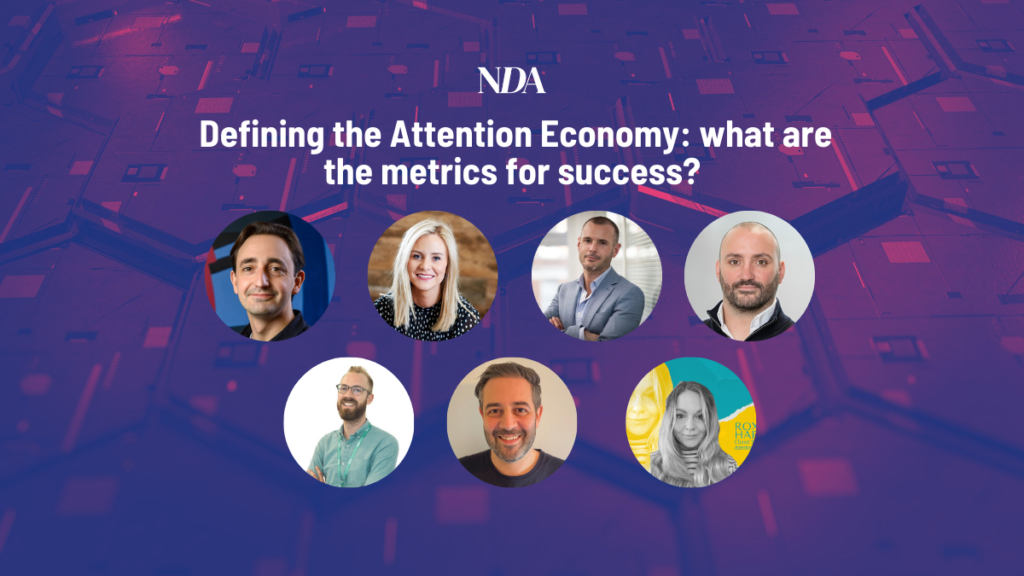With the deprecation of third-party cookies set to become a reality next year, the digital advertising industry is having to find different ways to reach audiences and measure outcomes. One of the major talking points is the attention economy, and why the industry should be looking to optimise toward attention, rather than outdated metrics like viewability or clicks.
To discuss what this all means, NDA recently held a roundtable on the topic of the attention economy. We were joined by Joseph Wood, Strategy Director, Spark Foundry; Amy Pearce, Sales Director UK, Teads; Nick Reid, SVP & Managing Director, DoubleVerify; Steve Richards, Data Partner, Wunderman Thompson; Niall Moody, Managing Director, Nano Interactive; Roxanne Harley, Director of Client Strategy, Azerion UK; and Rob Garber, Managing Director, GumGum.
The general consensus among the participants was that a shift toward attention is the right way forward, but there’s yet to be an agreement on how we should be defining attention.
“The attention conversation was going to happen already, but the death of the third-party cookie is a catalyst. It’s forcing us to look at something else,” according to Spark Foundry’s Wood.
He criticised the industry for becoming obsessed with measuring things that aren’t relevant to success, and believes that the combination of third-party cookies disappearing and a focus on attention will bring the industry back to where it needs to be.
“We’ve been so focused on measuring this thing that we ignore the things that actually matter, and attention gets us back to that,” he continued. “It focuses back on quality, rather than measuring something for the sake of it.”
Nano’s Moody sees the attention economy as being “a step toward addressing measurement and the challenges that will be thrust upon the industry”, but acknowledges that, though everyone has a point of view on it, “nobody has a definition that works”.
“The reason people talk about it being critical at the moment is because there’s an awful lot of research that shows if you get it right, and you find the right blend, you can achieve the outcomes that we’re trying to achieve. It’s just trying to, as an industry, work out what the framework that we all need to apply is.”
Defining attention
For GumGum’s Garber, the key is having “a standardisation of what attention is”, whether that comes from the Media Rating Council (MRC), Interactive Advertising Bureau (IAB), or another industry body.
“The baseline is the standard. We need to do that now, then we can all build off it. We’ll have our own nuances off of that to define how we can create better attention,” he said.
DoubleVerify’s Reid agreed that there is a “need to start with a baseline”, of media quality.
“Media quality starts with an authentic ad – an ad that’s fraud-free, seen by humans, brand safe, brand suitable, and in the right environment. That’s your baseline,” explained Reid. “Only upon that can you start measuring the impact of an ad and how it captures attention. This then feeds into thinking about planning, optimising the creative and more.”
Garber and Reid were also clear to point out that just shifting focus toward attention isn’t the only thing that should be considered, highlighting the importance of context, creative, and consumer trust in actually driving attention.
Factoring in attention
Azerion’s Harley agrees with the importance of other factors when thinking about attention, particularly creative.
“There’s been a switch to putting the consumer at the heart of the plan. The creative is very much where we start coming from now through all our campaigns, and we really challenge clients to do the homework and get to know their consumers,” Harley said.
Teads’ Pearce added: “This is where we need to start looking at the creative impact, understanding that copy performs differently in different environments. For example, an unoptimised TVC probably isn’t going to perform as well in a predominantly sound-off environment on mobile. We need to advise the client and make the optimisations. Therefore clients need to rely on media owners that have greater creative capabilities to add engaging interactivity, overlays, or simply a big bold call to action..
“Creative is more important than ever in the fight for attention and, using the knowledge and data we have, we need to start applying that on all campaigns.”
Attention not always the answer
Nonetheless, Harley believes it’s important to not get carried away with attention as a metric, because it “might not be the best measurement to prove ad effectiveness” in some cases. She said: “Attention is important, but you have to look beyond that if you’re actually going to make an impact for your brand.”
And Wunderman Thompson’s Richards agrees with this, warning that it shouldn’t be about just adding another metric to the mix, but using that metric to improve
“You want to feed the ecosystem. So, rather than slapping another metric on top, we should try to simplify it. Then people will innovate and work out ways to increase their attention. We need to get back to the baseline and say, ‘these are the table stakes. This is how we measure quality’,” Richards commented.









